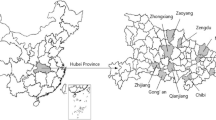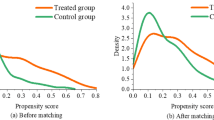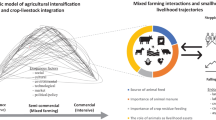Abstract
In the transition to low-carbon agriculture, smallholder farmers face more constraints. Identifying lead smallholder farmers and leveraging their peer effects can accelerate low-carbon agricultural technology extension among smallholder farmers. Based on survey data from 643 rice farmers in Zhejiang Province, China, this study constructs a finite mixture model (FMM) to identify lead smallholder farmers and then uses a quantile regression model (QRM) to explore their behavioral determinants. The main conclusions are as follows. First, despite the homogeneity in the production mode and resource constraints, lead smallholder farmers are younger and more open to risk, and they have higher educational levels and more family laborers. Second, a higher use efficiency of heterogeneous information is the key to differentiating lead smallholder farmers from other smallholder farmers. Third, green agricultural producer services can effectively alleviate resource constraints and contribute to the low-carbon transition of all smallholder farmers. These results can help redesign targeted extension policies to incentivize lead smallholder farmers.

Similar content being viewed by others
Data availability
The datasets generated and/or analyzed during the current study are not publicly available because we collected the data through a field investigation, and they are not available from the corresponding author upon reasonable request.
References
Andersson JA, D’Souza S (2014) From adoption claims to understanding farmers and contexts: a literature review of Conservation Agriculture (CA) adoption among smallholder farmers in southern Africa. Agr Ecosyst Environ 187:116–132. https://doi.org/10.1016/j.agee.2013.08.008
Bandiera O, Rasul I (2006) Social networks and technology adoption in northern Mozambique. Econ J 116(514):869–902. https://doi.org/10.1111/j.1468-0297.2006.01115.x
Banerjee A, Breza E, Chandrasekhar AG, Golub B (2018) When less is more: Experimental evidence on information delivery during India’s demonetization. Natl Bureau Econ Res
Battese GE (2010) A note on the estimation of Cobb-Douglas production functions when some explanatory variables have zero values. J Agric Econ 48(1–3):250–252. https://doi.org/10.1111/j.1477-9552.1997.tb01149.x
Beaman L, BenYishay A, Magruder J, Mobarak AM (2021) Can network theory-based targeting increase technology adoption? Am Econ Rev 111(6):1918–1943. https://doi.org/10.1257/aer.20200295
BenYishay A, Mobarak AM (2019) Social learning and incentives for experimentation and communication. Rev Econ Stud 86(3):976–1009. https://doi.org/10.1093/restud/rdy039
Chen M, Wang YQ, Yin SJ (2019) Research on the reformation path of China’s food safety certification policy: from the perspective of consumer preference. Economy and Management Publishing House, Bei**g
Conley TG, Udry CR (2010) Learning about a new technology: pineapple in Ghana. Am Econ Rev 100(1):35–69. https://doi.org/10.1257/aer.100.1.35
Du J (2020) Technology dispels autonomy: study on the dilemma of village governance after technology involvement. J Nan**g Agri Univ (social Sciences Edition) 20(3):62–68
Dimara E, Skuras D (2003) Adoption of agricultural innovations as a two-stage partial observability process. Agric Econ 28(3):187–196. https://doi.org/10.1111/j.1574-0862.2003.tb00137.x
Flor RJ, Maat H, Hadi BAR, Then R, Kraus E, Chhay K (2020) How do stakeholder interactions in Cambodian rice farming villages contribute to a pesticide lock-in? Crop Prot 135:104799. https://doi.org/10.1016/j.cropro.2019.04.023
Gao J, Peng C, Shi Q (2019) Study on the high chemical fertilizers consumption and fertilization behavior of small rural household in China: discovery from 1995–2016 national fixed point survey data. Manage World 35(10):120–132
Genius M, Koundouri P, Nauges C (2014) Information transmission in irrigation technology adoption and diffusion: social learning, extension services, and spatial effects. Am J Agr Econ 96(1):328–344. https://doi.org/10.1093/ajae/aat054
Gómez MI, Barrett CB, Raney T (2013) Post-green revolution food systems and the triple burden of malnutrition. Food Policy 42(10):129–138. https://doi.org/10.1016/j.foodpol.2013.06.009
Grabowski PP, Kerr JM (2014) Resource constraints and partial adoption of conservation agriculture by hand-hoe farmers in Mozambique. Int J Agric Sustain 12(1):37–53. https://doi.org/10.1080/14735903.2013.782703
Granovetter M (1978) Threshold models of collective behavior. Am J Sociol 83(6):1420–1443. https://doi.org/10.1086/226707
Han Q (2019) On the cohesion dilemma between family management and agricultural social service: based on M county Shandong Province. J Nan**g Agri Univ (Social Sciences Edition) 2:20–27+156
Holden ST, Fisher M, Katengeza SP, Thierfelder C (2018) Can lead farmers reveal the adoption potential of conservation agriculture? the case of Malawi. Land Use Policy 76:113–123. https://doi.org/10.1016/j.landusepol.2018.04.048
Holloway G, Shankar B, Rahmanb S (2002) Bayesian spatial probit estimation: a primer and an application to HYV rice adoption. Agric Econ 27(3):384–402. https://doi.org/10.1111/j.1574-0862.2002.tb00127.x
** SQ, Liu Y, Niu KY (2021) Driving green transformation of agriculture with low carbon: characteristics of agricultural sarbon emissions and its emission reduction path in China. Reform 5:29–37
Joffre OM, Poortvliet PM, Klerkx L (2019) To cluster or not to cluster farmers? influences on network interactions, risk perceptions, and adoption of aquaculture practices. Agric Syst 173:151–160. https://doi.org/10.1016/j.agsy.2019.02.011
Just RE, Zilberman D (1988) The effects of agricultural development policies on income distribution and technological change in agriculture. J Dev Econ 28(2):193–216. https://doi.org/10.1016/0304-3878(88)90058-2
Khaledi M, Weseen S, Sawyer E, Ferguson S, Gray R (2010) Factors influencing partial and complete adoption of organic farming practices in Saskatchewan Canada. Canadian J Agri Econ 58(1):37–56. https://doi.org/10.1111/j.1744-7976.2009.01172.x
Kasahara H, Shimotsu K (2009) Nonparametric identification of finite mixture models of dynamic discrete choices. Econometrica 77(1):135–175. https://doi.org/10.3982/ECTA6763
Krishnan P, Patnam M (2014) Neighbors and extension agents in Ethiopia: who matters more for technology adoption? Am J Agr Econ 96(1):308–327. https://doi.org/10.1093/ajae/aat017
Lalani B, Dorward P, Holloway G, Wauters E (2016) Smallholder farmers’ motivations for using conservation agriculture and the roles of yield, labour and soil fertility in decision making. Agric Syst 146:80–90. https://doi.org/10.1016/j.agsy.2016.04.002
Li X, Gao Q (2013) Behavioral logic, differentiation results and prospects: the inspection of rural-household differentiation since the reform in China. Issues in Agricultural Economy 2:56–65+111
Llewellyn RS, Brown B (2020) Predicting adoption of innovations by farmers: what is different in smallholder agriculture? Appl Econ Perspect Policy 42(1):100–112. https://doi.org/10.1002/aepp.13012
Lou D, Kong XZ (2013) The multi-dimensional development mode and realistic reflection of the new agricultural management entities. Reform 2:65–77
Ma XD, Shao LQ, Huo XX (2018) Is pattern of difference sequence the cause of technology lock-in in farmers’ production? —based on the perspective of technology network embedding. J Huazhong Agri Univ (social Sciences Edition) 6:20–28
Marenya PP, Barrett CB (2007) Household-level determinants of adoption of improved natural resources management practices among smallholder farmers in western Kenya. Food Policy 32(4):515–536. https://doi.org/10.1016/j.foodpol.2006.10.002
Marra M, Pannell DJ, Ghadim AA (2003) The economics of risk, uncertainty and learning in the adoption of new agricultural technologies: where are we on the learning curve? Agric Syst 75(2–3):215–234. https://doi.org/10.1016/S0308-521X(02)00066-5
Maertens A (2017) Who cares what others think (or do)? social learning and social pressures in cotton farming in India. Am J Agr Econ 99:988–1007. https://doi.org/10.1093/ajae/aaw098
Maertens A, Michelson H, Nourani V (2021) How do farmers learn from extension services? Evidence from Malawi. Am J Agr Econ 103(2):569–595. https://doi.org/10.1111/ajae.12135
Munshi K (2004) Social learning in a heterogeneous population: technology diffusion in the Indian Green Revolution. J Dev Econ 73(1):185–213. https://doi.org/10.1016/j.jdeveco.2003.03.003
Rogers EM (2003) Diffusion of innovations fifth ed. Free Press, New York
Shikuku KM, Pieters J, Bulte E, Läderach P (2019) Incentives and the diffusion of agricultural knowledge: experimental evidence from northern Uganda. Am J Agr Econ 101(4):1164–1180. https://doi.org/10.1093/ajae/aaz010
Snyder CS, Bruulsema TW, Jensen TL (2009) Review of greenhouse gas emissions from crop production systems and fertilizer management effects. Agr Ecosyst Environ 133(3–4):247–266. https://doi.org/10.1016/j.agee.2009.04.021
Sun M (2021) Changes in the supply mode of basic agricultural technology services and the dilemma of farmers’ technology acquisition. Issues in Agricultural Economy 3:50–42
Sun XY, Liu Y (2019) Can land trusteeship improve farmers’ green production? Chinese Rural Econ 10:60–80
Szmedra PI, Wetzstein ME, Mcclendon RW (1990) Partial adoption of divisible technologies in agriculture. J Agri Econ Res 69(5):1097–1097. https://doi.org/10.22004/ag.econ.139032.
Valente TW (1996) Social network thresholds in the diffusion of innovations. Social Netw 18(1):69–89. https://doi.org/10.1016/0378-8733(95)00256-1
Wagner CH, Cox M, Robles JLB (2016) Pesticide lock-in in small scale Peruvian agriculture. Ecol Econ 129:72–81. https://doi.org/10.1016/j.ecolecon.2016.05.013
Wang GL, Lu Q (2015) The test of the U-type relationship between the social network’s impact and the farmers’ technology adoption–-case of adoption of water saving irrigation technology in Minqin, Gansu. J Agrotech Econ 10:92–106
Ward PS, Pede VO (2015) Capturing social network effects in technology adoption: the spatial diffusion of hybrid rice in Bangladesh. Austral J Agri Resour Econ 59(2):225–241. https://doi.org/10.1111/1467-8489.12058
**ong H, **ao LP (2021) Peer effects in the diffusion of innovation: a case study on the adoption of new crop variety. Journal of Huazhong Agricultural University (Social Sciences Edition) 3:93–106+187–188
Yin SJ, Li R, Wu LH, Chen XJ (2018) Introduction to 2018 China development report on food safety. Peking University Press, Bei**g
Yin SJ, Wang YQ, Li K (2019) Pre-certification or retrospective? ——the study of consumer preferences for food safety information labels and their interactive relationships. China Rural Survey 5:127–144
Yin Z (2017) Professional village cadres group and grassroots governance patterning: from the fields experience of the outer suburbs of Shanghai City. Journal of Nan**g Agricultural University (Social Sciences Edition) 17(2):42–49+151
Zakaria A, Azumah SB, Appiah-Twumasi M, Dagunga G (2020) Adoption of climate-smart agricultural practices among farm households in Ghana: the role of farmer participation in training programmes. Technol Soc 63:101338. https://doi.org/10.1016/j.techsoc.2020.101338
Zeng N, Zhao F, Collatz GJ, Kalnay E, Salawitch RJ, West TO, Guanter L (2014) Agricultural green revolution as a driver of increasing atmospheric CO2 seasonal amplitude. Nature 515(7527):394–397
Zeweld W, Van Huylenbroeck G, Tesfay G, Speelman S (2017) Smallholder farmers’ behavioural intentions towards sustainable agricultural practices. J Environ Manage 187:71–78. https://doi.org/10.1016/j.jenvman.2016.11.014
Zhang L (2020) Small household differentiation, behavioral differences and agricultural chemical reduction. Issues in Agricultural Economy 6:131–142
Zhang L, Luo BL (2020) Agricultural chemical reduction: the logic and evidence based on farmland operation scale of households. Chinese Rural Econ 2:81–99
Zheng XY, Wang F, Ying RY (2018) Farmers’ endowment constraints, technical properties and agricultural technology selection preferences: an analytical framework of farmers’ technology adoption under an incomplete factor market. Chinese Rural Econ 3:105–122
Zhou J (2017) The dual division of agricultural socialization service and its consequences under the background of land circulation. J Nan**g Agri Univ (Social Sciences Edition) 6:141–151+166
Zhu YJ (2016) Adoption and diffusion of agricultural innovations: from perspective of social network. Chinese Rural Economy 9:58–71
Funding
This work was supported by the National Social Science Fund of China (20CGL027).
Author information
Authors and Affiliations
Contributions
All authors contributed to the study’s conception and design. Kai Li and Qi Li were responsible for conceptualization, methodology, data collection, and formal analysis. The first draft of the manuscript was written by Kai Li, and all authors commented on previous versions of the manuscript. All authors read and approved the final manuscript.
Corresponding author
Ethics declarations
Ethical approval
Not applicable.
Consent to participate
Not applicable.
Consent for publication
Not applicable.
Competing interests
The authors declare no competing interests.
Additional information
Responsible Editor: Bao**g Gu
Publisher's Note
Springer Nature remains neutral with regard to jurisdictional claims in published maps and institutional affiliations.
Rights and permissions
Springer Nature or its licensor (e.g. a society or other partner) holds exclusive rights to this article under a publishing agreement with the author(s) or other rightsholder(s); author self-archiving of the accepted manuscript version of this article is solely governed by the terms of such publishing agreement and applicable law.
About this article
Cite this article
Li, K., Li, Q. Towards more efficient low-carbon agricultural technology extension in China: identifying lead smallholder farmers and their behavioral determinants. Environ Sci Pollut Res 30, 27833–27845 (2023). https://doi.org/10.1007/s11356-022-24159-2
Received:
Accepted:
Published:
Issue Date:
DOI: https://doi.org/10.1007/s11356-022-24159-2




